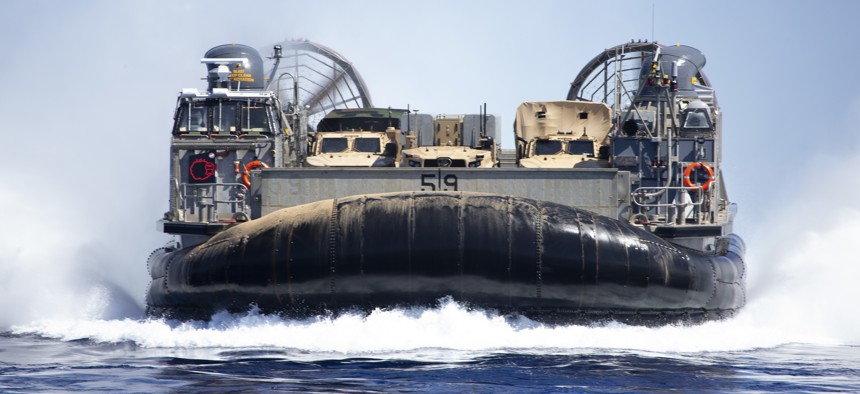
A Navy Marine Expeditionary Ship Interdiction System launcher, a command and control vehicle and a Joint Light Tactical Vehicle are transported by a U.S. Navy Landing Craft Air Cushion from Pacific Missile Range Facility Barking Sands, Hawaii, out to USS San Diego for Large Scale Exercise 2021 on Aug. 16, 2021. U.S. Marine Corps / Cpl. Luke Cohen
Retired admirals, Project Overmatch will figure in Navy’s upcoming giant exercise
The second annual edition of the Large Scale Exercise will feature multiple crises erupting around the world.
Retired admirals will join this year’s version of the U.S. Navy’s globe-spanning Large Scale Exercise, which will aim—among other things—to simulate the dynamics of fleet-to-COCOM communications.
“So one of the big differences is we weren't as robust in ’21 on the fleet commander-to-combatant commander relationship that we think is going to be crucial in a fight of a peer competitor,” Adm. Daryl Caudle, the commander of U.S. Fleet Forces Command, told reporters Monday. Low-density, high-demand assets—ships, subs, etc.—“are going to have to be balanced across the globe, that allocate those forces and capabilities at the right capacity, at the right timing and tempo.”
Large Scale Exercise 23, which will run from Aug. 9 to 18, will sprawl around the globe, involving more than 25,000 sailors and Marines across 22 time zones and six geographical combatant commands. Run from the Navy Warfare Development Center at Naval Station Norfolk, Virginia, this second edition of the naval exercise will require more than a thousand people just to run it.
Among them will be more than a dozen active and retired senior officers, who will advise the scenario runners portraying defense leaders and command staffers and help simulate the stressful dynamics of senior decision-making. One is James Foggo, former commander of U.S. Naval Forces Europe/Africa; another is Scott Swift, former U.S. Pacific Fleet commander.
This year’s Large Scale Exercise will aim to continue rehearsing and developing various relatively new naval operating concepts: distributed maritime operations, or DMO; littoral operations in a contested environment, or LOCE; and expeditionary advanced base operations, or EABO.
Marines based in Cherry Point, North Carolina, will run the Ground/Air Task Oriented Radar and serve at the tactical level for those concepts, according to Marine Lt. Col. Robert Shuford, a spokesman with Marine Forces Command.
“With DMO, we need to be able to one, distribute our forces—we need to be able to dynamically maneuver them while they're operating. At the same time, they all have to remain integrated with one another. So that's a challenge. So, we need to work toward that and that's one of the main pieces of this exercise,” Navy Capt. Chris Narducci, LSE 23’s lead planner, said Monday.
The exercise will again be interlinked through the Navy’s live-virtual-constructive training environment, allowing participants to join from wherever they are around the globe and be positioned virtually wherever the exercise needs.
LSE23 will involve nine maritime operations centers, six carrier strike groups, three amphibious readiness groups, and 25 live ships and submarines—plus more than 50 “virtual ships,” according to a presentation about the exercise.
While the officials would not discuss the exact scenario for the exercise, Caudle said it will involve “a very aggressive, percolating event” that eventually leads to conflict. When war erupts, other enemies will attempt to take advantage. These multiple events around the world will ensure that the various participating commands “are fairly challenged in this. And that’s what tensions the resources that we have and making sure we’re getting the allocation correct,” he said.
Caudle said the exercise incorporates lessons from Ukraine, including how to best posture forces for deterrence or offensive missions based on indications and warnings from intelligence.
“So it's the relationship…between the intelligence communities, our ability to process that at our maritime operations centers, our ability to work with our component commanders and combat commander relationships, to posture forces most effectively,” he said. “So, I think the Ukraine conflict with Russia illustrates the need to be able to do that efficiently.”
U.S. Naval Forces Europe and Marine Forces Europe will be able to incorporate their recent real-world experiences into the exercise, said Lt. Gen. Brian Cavanaugh, the commander of Marine Forces Command.
The exercise will test communications technologies deployed to ships under the Navy’s Project Overmatch, said Caudle, who declined to go into detail. LSE23 participants that have been testing Overmatch capabilities include the Carl Vinson carrier strike group.
“And the fact that we're bringing that to bear in this live, virtual, constructed manner allows us to try to test some Overmatch capabilities that we maybe couldn't do in real world just because the situation wouldn't necessarily lend itself to that during an actual deployment,” he said.


